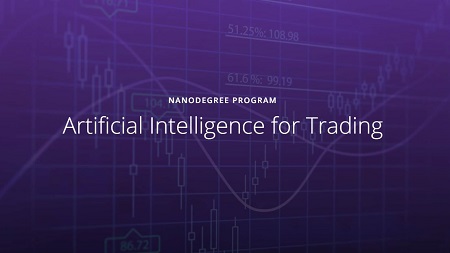
English | MP4 | AVC 1280×720 | AAC 44KHz 2ch | 32h 34m | 5.85 GB
Complete real-world projects designed by industry experts, covering topics from asset management to trading signal generation. Master AI algorithms for trading, and build your career-ready portfolio.
In this program, you’ll analyze real data and build financial models for trading. Whether you want to pursue a new job in finance, launch yourself on the path to a quant trading career, or master the latest AI applications in quantitative finance, this program offers you the opportunity to master valuable data and AI skills.
Table of Contents
1 Welcome to the Nanodegree Program
2 Get Help from Peers and Mentors
3 Get Help with Your Account
4 Stock Prices
5 Market Mechanics
6 Data Processing
7 Stock Returns
8 Momentum Trading
9 Project 1 Trading with Momentum
10 Quant Workflow
11 Outliers and Filtering
12 Regression
13 Time Series Modeling
14 Volatility
15 Pairs Trading and Mean Reversion
16 Project 2 Breakout Strategy
17 Stocks, Indices, Funds
18 ETFs
19 Portfolio Risk and Return
20 Portfolio Optimization
21 Project 3 Smart Beta and Portfolio Optimization
22 Factors
23 Factor Models and Types of Factors
24 Risk Factor Models
25 Time Series and Cross Sectional Risk Models
26 Risk Factor Models with PCA
27 Alpha Factors
28 Alpha Factor Research Methods
29 Advanced Portfolio Optimization
30 Project 4 Alpha Research and Factor Modeling
31 Welcome To Term II
32 Intro to Natural Language Processing
33 Text Processing
34 Feature Extraction
35 Financial Statements
36 Project 5 NLP on Financial Statements
37 Introduction to Neural Networks
38 Deep Learning with PyTorch
39 Recurrent Neural Networks
40 Training Neural Networks
41 Embeddings Word2Vec
42 Sentiment Prediction RNN
43 Project 6 Sentiment Analysis with Neural Networks
44 Coming Soon!
45 Coming soon!
46 Why Python Programming
47 Data Types and Operators
48 Control Flow
49 Functions
50 Scripting
51 Introduction
52 Vectors
53 Linear Combination
54 Linear Transformation and Matrices
55 Jupyter Notebooks
56 NumPy
57 Pandas
58 Descriptive Statistics – Part I
59 Descriptive Statistics – Part II
60 Admissions Case Study
61 Probability
62 Binomial Distribution
63 Conditional Probability
64 Bayes Rule
65 Python Probability Practice
66 Normal Distribution Theory
67 Sampling distributions and the Central Limit Theorem
68 Confidence Intervals
69 Hypothesis Testing
70 Case Study AB tests
71 Linear Regression
72 Naive Bayes
73 Clustering
74 Decision Trees
75 Introduction to Kalman Filters
76 Introduction to Neural Networks
77 Intro to Computer Vision
78 Intro to NLP
Resolve the captcha to access the links!